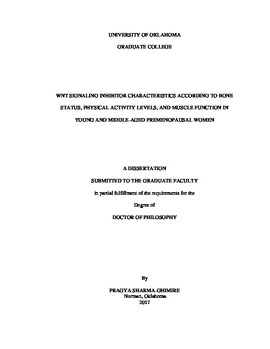| dc.description.abstract | Introduction: Bone metabolism is regulated by the Wnt signaling pathway and is considered to be crucial for skeletal development. There are two glycoproteins that inhibit Wnt function and bone metabolism: sclerostin and Dickkopf-1 (DKK-1). These are novel markers of bone metabolism and could be considered valuable tools to investigate the mechanisms of bone remodeling. Although the mechanism of the Wnt signaling pathway and its inhibitors on bone biology has been well studied, only sparse data are available in humans, especially related to age and physical activity differences in circulating levels of sclerostin and DKK-1.
Purpose: The primary purpose of this study was to compare serum concentrations of sclerostin and DKK-1 in young and middle-aged premenopausal women. These age groups were selected to allow comparisons between women who are still accruing bone mass versus those who have already achieved their peak bone mass. The present study also evaluated the differences in sclerostin and DKK-1 concentrations based on physical activity status {low, moderate, and health enhancing physical activity (HEPA-active)}.This study further analyzed the relationship between bone density variables, jump trials and leg strength with the serum concentrations of sclerostin and DKK-1.
Methods: In this non-randomized cross-sectional research design, a total of 50 young (n=25) and middle-aged (n=25) women participated and completed all protocols. During the first visit, participants completed informed consent and HIPAA forms, and questionnaires on physical activity, calcium intake, and menstrual history. During the second visit, a blood sample was drawn to measure serum levels of sclerostin, DKK-1 and follicle-stimulating hormone (FSH). Participants’ body composition (percent body fat, fat mass, fat-free mass and bone-free lean body mass), areal bone mineral density (aBMD), and bone mineral content ( BMC) of total body, lumbar spine, and dual proximal femur was measured with Dual Energy X-ray Absorptiometry (DXA). Participants’ non-dominant tibia (4%, 38%, and 66% sites) was measured with peripheral Quantitative Computed Tomography (pQCT). Lower body strength and power were assessed by a two-leg press maximal strength test (1RM) and a vertical jump test.
Results: Sclerostin levels were significantly lower in young women compared to middle-aged women (p<0.001). No significant age group and physical activity differences were observed for DKK-1 levels. Sclerostin levels were significantly higher in HEPA-active women compared to low-moderately active women (p<0.05). Sclerostin was significantly but weakly positively related with spine L1-L4 aBMD, spine L1-L4 Z-Score, several hip aBMD variables, specifically, right neck Z-Score, left neck Z-Score, right trochanter BMD, right trochanter Z-Score, left trochanter Z-score and total hip right aBMD. DKK-1 also weakly positively related with spine L1-L4 aBMD, spine L1-L4 Z-Score, right and left trochanter aBMD, and right and left trochanter Z-Scores. There was a significant moderate positive relationship between sclerostin and cortical vBMD at 38% tibia. The correlations ranged from (r=0.24 to 0.50; p <0.05). There were significant but small negative associations (r=0.27, p<0.05) between time in air and vertical jump height with sclerostin levels.
Conclusions: Sclerostin concentrations were significantly higher in the middle-aged women, which supports a potential role for sclerostin in age-related bone health. The results from the current study found higher sclerostin concentrations in women participating in a high volume of physical activity. Age group and physical activity status were associated with higher serum sclerostin levels. Although Wnt signaling inhibitors are the negative regulator of bone mass, the findings of a low positive association between sclerostin/DKK-1 with BMD were unexpected. Further, the current findings may provide preliminary data for future research on exercise interventions and Wnt signaling inhibitors. | en_US |
